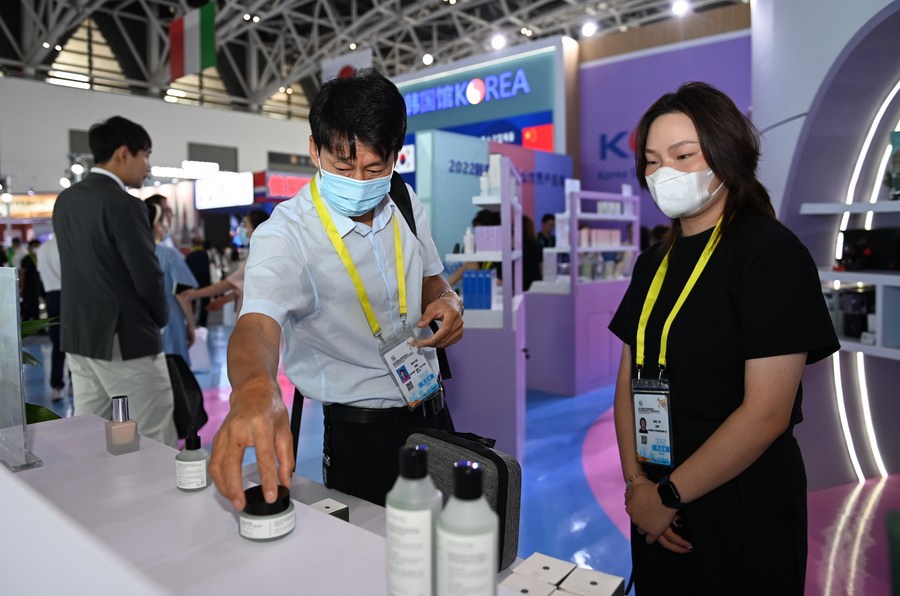Decade Success: Economic ties closer among Belt and Road countries

Visitors learn about cosmetics at the Republic of Korea booth during the Sixth Silk Road International Exposition in Xi'an, northwest China's Shaanxi Province, Aug. 14, 2022. (Xinhua/Li Yibo)
The ongoing Sixth Silk Road International Exposition that kicked off on Sunday in Xi'an, capital of northwest China's Shaanxi Province, has given foreign entrepreneurs a window into the broad Chinese market.
With closer Belt and Road cooperation high on the agenda, the expo has attracted participants from over 70 countries and regions, including Thailand and Singapore. Uzbekistan serves as the guest country of honor.
In the pavilion of the Republic of Korea (ROK), more than 100 items from 34 ROK companies are on display, including cosmetics products that are popular in China.
"With the deepening of the Belt and Road Initiative (BRI), we have paid more attention to the economic development in northwest China instead of those coastal areas. Many enterprises are preparing to settle down in China's northwestern regions such as Shaanxi," said Sung Haelee, representative of an ROK SMEs (small and medium-sized enterprises) and startups agency based in Xi'an.
"Although the exhibitors are mainly consumer goods companies this year, many tech enterprises are also looking forward to taking part in the expo next time," Sung added.
BROADER MARKET, MORE OPPORTUNITIES
Proposed by China in 2013, BRI aims to build trade and infrastructure networks connecting Asia with Europe and beyond along the ancient Silk Road trade routes for common development and prosperity.
The past nine years witnessed substantial progress in trade and investment under the initiative.
From 2013 to 2021, the total volume of trade of goods between China and the Belt and Road countries was nearly 11 trillion U.S. dollars, while two-way investment exceeded 230 billion dollars, according to the Ministry of Commerce.
By the end of 2021, China had built 79 zones for economic and trade cooperation in 24 B&R countries, investing 43 billion dollars and creating 346,000 local jobs.
By the end of July 2022, China had signed more than 200 BRI cooperation agreements with 149 countries and 32 international organizations, according to the National Development and Reform Commission, the country's top economic planner.
Central Asian countries like Uzbekistan play an active part under the BRI today and are tapping the huge market potential of China.
Data shows that the bilateral trade volume between China and Uzbekistan amounted to 8.05 billion dollars in 2021, up 21.6 percent from 2020.
"As the most populous country in the world, China represents a large market endowed with unparalleled opportunities. We have helped many Uzbek companies find the targeted market and set up offices in different parts of China," said Sulaymanov Djamshid, representative of the Chamber of Commerce and Industry of Uzbekistan in China.
More than 20 Uzbek enterprises have set up representative offices in Chinese cities, like Qingdao, Xi'an and Urumqi, indicating a rosy prospect of China-Uzbekistan economic ties.
NEW HIGHLIGHTS
The National Development and Reform Commission and three relevant departments issued a guideline in March, saying that China will promote the green development of the Belt and Road and strengthen international cooperation in this regard.
At this year's expo, a variety of green and intelligent products are on display, from electric vehicle charging facilities to patrol robots. Among them, two pure electric drive assemblies have hogged the limelight.
"The newly-developed assembly can be equipped on wide-body mining trucks, heavy-loaded tractors and the like, which provides the same power as diesel but without noise and greenhouse gas emissions," said Xie Yuanxin, with Shaanxi Fast Auto Drive Group Co., Ltd., a producer of auto transmission and driveline systems.
Since the first batch of 300 light trucks equipped with such assemblies were exported to Colombia in 2019, the company has broadened its overseas market of green products to countries including Thailand, South Africa and Mexico.
While China is pursuing green development, more overseas investors see business opportunities here.
Established in Shanghai in 2020, Tera Energies, a French-funded company, aims to provide clean-energy and low-carbon solutions to Chinese partners from traditional industries.
"We saw business opportunities from China's carbon-cutting goals. Since our founding, we have carried out more than 10 projects with Chinese companies," said Fu Minxi of Tera Energies, adding that the expo is also a chance for the company to explore the market in northwest China.
(Video reporters: Zhao Yingbo, Xin Rui and Zhang Sijie; video editors: Peng Ying, Zhu Cong and Cao Ying.)